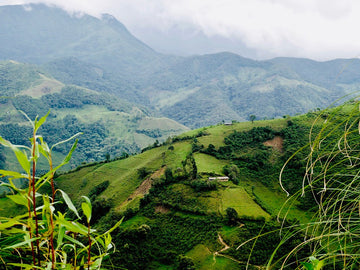Where does coffee come from and how does that impact the flavour?
par Equator Coffee Roasters sur Jun 24, 2021

There is a growing movement for understanding where your food comes from. From the meat on your dinner table to the almond milk in your fridge, understanding how your food gets from the land to your table empowers you to make purchasing decisions that are inline with your personal values. The same cannot be more true with coffee. In this series, we will cover coffee from crop to cup.
A coffee bean's origin, the climate in which it’s grown, and it’s variety all have a part to play in the flavour of the coffee before it is even roasted! In this blog post, we will explore the origin of coffee and how that impacts the flavour of the final product.
The coffee plant’s ideal growing conditions
First thing is first. The coffee plant. The coffee plant ranges in size and stature from a small tree to a stout shrub. There are over a hundred species of the coffee plant, but only two are cultivated for consumption: Arabica and Robusta. Arabica coffee tends to be of higher quality and more sophisticated in flavour and is quite a bit more “demanding” in its ideal growing conditions than its sturdier, lower grade, shrubby cousin, Robusta.
To yield the best quality, Arabica coffee (at minimum!) requires:
- Temperatures of 18 - 21 degrees celsius;
- Just enough rain but not too much;
- Warm days and cool nights;
- Elevation of 800-2000 metres above sea level
These conditions are ideal for the plant to thrive and produce abundant, delicious coffee cherries, resulting in a great cup of coffee. You may have heard the term ‘shade grown’. Coffee plants are part of a larger ecosystem and thrive under a canopy of shade trees. Think of it like a tomato plant in your garden: you ensure the tomato plant is in full sun with lots of water and nutrients in order to thrive, and any other conditions will not guarantee great tomatoes. The same is true for coffee; farmers just have to get creative with their mountain-side harvesting techniques.
On the other hand, Robusta coffee is grown in plantation-style farms, open sun, no shade, low elevation. Though more robust (hence the name), the overall quality rarely can match that of the Arabica.
Where do you find these growing conditions?
So this leads us into the next variable: region. Mountainous regions with medium to high elevation and ideal temperatures are found in Latin America, Asia, and Africa, spotted around the equator (hence, our name “Equator”). The countries in these regions each have a unique terroir with specific countries and regions known for specific flavour notes. Just like wine, coffee can grow in microclimates that produce different flavours in the coffee bean itself. Ultimately, it is the roastmaster who determines which flavour profiles get highlighted in the roasting process (read more about that here!).
So how do roasters choose which coffee to purchase?
So now we know where the coffee grows and what varieties exist, how does Equator choose which coffee to purchase? To put it simply, we look for flavour, quality, and most importantly, a strong relationship with the producer.
Equator only purchases specialty coffee, the highest grade coffee in the world. Specialty coffee is inspected, tasted, and graded on an international, bona fide grading scale. Coffees that meet the standards of the SCA (Specialty Coffee Association) are sold as specialty coffee. For our blends, Equator selects coffee that meets our desired flavour-profiles to keep the coffee you drink familiar and delicious. But moreso, we are looking for producer partners (the farmers) with whom we can have a long standing relationship. By doing this, we get consistently great, high-quality coffee for you to enjoy.
Equator’s top origins
The top origins Equator sources from are Peru, Guatemala, and Nicaragua. Equator has been purchasing from the same cooperative in each of these countries for over 10 years. From this relationship we receive consistently delicious coffee, sophisticated quality assurance and communications with their teams, and the opportunity to visit our partners regularly.
So what does all this have to do with the flavour of the coffee?
Each of these coffees adds a different dimension to the blend. For instance, coffee from Peru tends to be very sweet. This would be balanced in our blends with complementary flavours. The higher the elevation, the brighter the coffee tends to be. High elevation countries in East Africa create a smaller, denser coffee bean, which when roasted lightly, you will find flavours like Ethiopian bergamot or black tea. While coffee from Central America are known for their versatility, Mexico and Guatemala produce robust coffees that boast chocolatey notes. Because of this, different origins lend themselves better to different roasts.
Our Single Origin coffee series highlights a coffee from one coop in one country. These coffees are typically lightly roasted, making them the best way to taste the nuance each country’s terroir has to offer.
To get notified when we publish new blog posts like this, subscribe to our newsletter!
